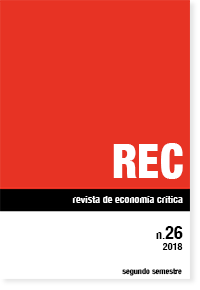How to guarantee the right to work? The basic income alternative
Keywords:
right to work, labor rights, direct job creation, universal basic incomeAbstract
In this paper, firstly, the contemporary labor market is analyzed, particularly its characteristics of precarity and a smaller number of labor rights recognized. Secondly, it is argued that the best way to understand the right to work is as the right to social recognition and some proposals to make effective this right are studied like de complementary wage, the direct job creation or the universal basic income.
Downloads
References
Alexy, R. (1993). Teoría de los derechos fundamentales, trad. E. Garzón Valdés. Madrid: Centro de Estudios Constitucionales.
Arcarons, J., Raventós, D. & Torrens, Ll. (2017). Renta Básica incondicional. Una propuesta de financiación racional y justa. Barcelona: Ediciones del Serbal.
Asís, R. de (2001). Sobre el concepto y el fundamento de los Derechos: una aproximación dualista. Madrid: Instituto de Derechos Humanos Bartolomé de las Casas-Dykinson.
Barragué, B. (2017). Desigualdad e igualitarismo predistributivo. Madrid: Centro de Estudios Constitucionales.
Barry, B. (2005). Why Social Justice Matters. Cambridge: Polity.
Beck, U. (2000). Un nuevo mundo feliz. La precariedad del trabajo en la era de la globalización. Barcelona: Paidós.
Ben-Israel, R. (2001). The Rise Fall and Resurrection of Social Dignity. En Labor Law, Human Rights and Social Justice. La Haya: Kluwer.
Colectivo Charles Fourier (1985). Une réflexion sur l'allocation universelle. La Revue Novelle, 4, 345-351.
Cortina, A. & Conill, J. (2002). Cambio en los valores del trabajo. Sistema, 168-169, 3-15. Elster, J. (1988). Comentario sobre Van der Veen y Van Parijs. Zona Abierta, 46-47, 113-128.
Elster, J. (1988). Is There (or Should There Be) a Right to Work?. En Gutmann, A. (ed.), Democracy and the Welfare State (pp. 53-78). Pricenton: Pricenton University Press.
https://doi.org/10.2307/j.ctv14163mz.8
Esping-Andersen, G. (1993). Los tres mundos del Estado del bienestar. Valencia: Edicions Alfons el Magnánim- IVEI.
Ferrajoli, L. (1999). Derechos y garantías. La ley del más débil, trad. P. Andrés Ibáñez y A. Greppi. Madrid: Trotta.
Forstater, M. (1999). Functional Finance and Full Employment: Lessons from Lerner to Today. Journal of Economic Issues, 33 (2), 475-482.
https://doi.org/10.1080/00213624.1999.11506180
Garzón Espinosa, E. (2015a). Perspectiva económica del trabajo garantizado. En Garzón, A. y Guamán, A. (eds.), El trabajo garantizado. Una propuesta necesaria frente al desempleo y la precarización (pp. 69-96). Madrid: Akal.
Garzón Espinosa, E. (2015b). Trabajo garantizado. Alkaid, 22, 42-51. Garzón Valdés, E. (1989). Representación y democracia. Doxa, 6, 143-164.
https://doi.org/10.14198/DOXA1989.6.07
Goodin, R. (1998). Social Welfare as Collective Social Responsibility. En Schmidtz, D. y Goodin, R. E., Social Welfare and Individual Responsibility (pp. 97-195). Nueva York: Cambridge University Press.
Harvey, P. (2004). The Right to Work and Basic Income Guarantees: Cometing or Complementary Goals? Ponencia presentada en el X Congreso de la BIEN, Barcelona, 19 y 20 de septiembre.
Lodemel, I. & Trickey, H. (2001). A New Contract for Social Assistance. En An Offer You Can't Refuse (pp. 1-39). Bristol: The Policy Press.
https://doi.org/10.1332/policypress/9781861341952.003.0001
Mead, L. (1992). The New Politics of Poverty. The Nonworking Poor in America. Nueva York: Basic Books.
Mundlak, G. (2007). Derecho al trabajo. Conjugar derechos humanos y política de empleo. Revista Internacional del Trabajo, 126 (3-4), 213-242.
https://doi.org/10.1111/j.1564-9148.2007.00013.x
Murphy, L. y Nagel, T. (2002). The Myth of Ownership. Taxes and Justice. Oxford: Oxford University Press.
https://doi.org/10.1093/0195150163.001.0001
Peces-Barba Martínez, G. (1995). Curso de Derechos Fundamentales, con la colaboración de R. de Asís, C. Fdez. Liesa y Á. Llamas. Madrid: BOE-Universidad Carlos III.
Phelps, E. S. (1997). Rewording Work. How to Restore Participation and Self-Support to Free Enterprise. Londres: Harvard University Press.
https://doi.org/10.4159/9780674042117
Randall Wray, L. (1999). Public Service Employment-Assured Job Program: Further Considerations. Journal of Economics Issues, 33 (2), 483-490.
https://doi.org/10.1080/00213624.1999.11506181
Rey Pérez, J. L. (2007). El derecho al trabajo y el ingreso básico. ¿Cómo garantizar el derecho al trabajo? Madrid: Dykinson.
Rey Pérez, J.L. (2015). Empleo y pobreza. El fenómeno de los trabajadores pobres como negación del derecho al Trabajo. En Álvarez Vélez, M.I. y Rey Pérez, J. L. (dir.), Derecho y Pobreza. Cizur Menor: Aranzadi.
Rifkin, J. (1997). El fin del trabajo: el declive de la fuerza de trabajo global y el nacimiento de la era posmercado. Barcelona: Círculo de Lectores.
Schwarzenbach, S. A. (2005). The Limits of Production: Justifying Guaranteed Basic Income. En Standing, G. (ed.), Promoting Income Security as a Right: Europe and North America (pp. 97-114). Londres: Anthem Press.
Standing, G. (2011). The Precariat. The New Dangerous Class. Londres: Bloomsbury.
https://doi.org/10.5040/9781849664554
Van Donselaar, G. (2009). The Right to Exploit. Parasitism, Scarcity, Basic Income. Oxford: Oxford University Press.
https://doi.org/10.1093/acprof:oso/9780195140392.001.0001
Van Parijs, P. (1996). Libertad real para todos. Qué puede justificar el capitalismo (si hay algo que pueda hacerlo), trad. J. Francisco Álvarez. Barcelona: Paidós.
White, S. (2003). The Civic Minimum: An Essay on the Rights and Obligations of Economic Citizenship. Oxford: Oxford University Press.
https://doi.org/10.1093/0198295057.001.0001
Zubero, I. (2007). ¿A qué huele en Dinamarca? Lan Harremanak, 16, 35-58.
Downloads
Published
How to Cite
Issue
Section
License
This licence allows third parties to share (copy and redistribute the material in any medium or format) and adapt (remix, transform and create from the material for any purpose, including commercial purposes), provided that authorship and first publication in this journal (The Journal, DOI of the work) is acknowledged, a link to the licence is provided, and it is stated whether changes have been made to the work.







